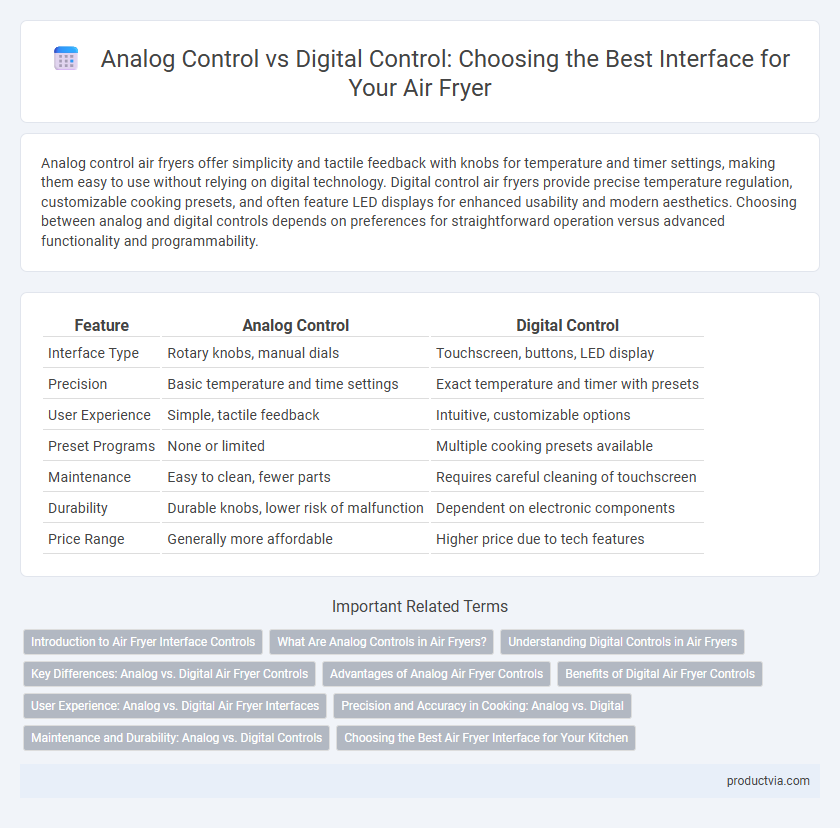Analog control air fryers offer simplicity and tactile feedback with knobs for temperature and timer settings, making them easy to use without relying on digital technology. Digital control air fryers provide precise temperature regulation, customizable cooking presets, and often feature LED displays for enhanced usability and modern aesthetics. Choosing between analog and digital controls depends on preferences for straightforward operation versus advanced functionality and programmability.
Table of Comparison
| Feature | Analog Control | Digital Control |
|---|---|---|
| Interface Type | Rotary knobs, manual dials | Touchscreen, buttons, LED display |
| Precision | Basic temperature and time settings | Exact temperature and timer with presets |
| User Experience | Simple, tactile feedback | Intuitive, customizable options |
| Preset Programs | None or limited | Multiple cooking presets available |
| Maintenance | Easy to clean, fewer parts | Requires careful cleaning of touchscreen |
| Durability | Durable knobs, lower risk of malfunction | Dependent on electronic components |
| Price Range | Generally more affordable | Higher price due to tech features |
Introduction to Air Fryer Interface Controls
Air fryer interface controls are crucial for precise cooking performance and user convenience, with analog and digital options offering distinct experiences. Analog controls use mechanical dials to adjust temperature and time, providing straightforward but less precise settings compared to digital controls, which feature touchscreens or buttons for exact input and programmable presets. Digital control interfaces enhance usability with programmable timers, temperature accuracy, and easy-to-read displays, making them more suitable for modern kitchen technology demands.
What Are Analog Controls in Air Fryers?
Analog controls in air fryers use mechanical dials or knobs to adjust temperature and cooking time, providing a straightforward and tactile user interface. These controls rely on physical components such as rotary switches or timers, offering simplicity and durability without digital displays or touchscreens. Analog control air fryers are favored for their ease of use, reliability, and often lower cost compared to digital control models.
Understanding Digital Controls in Air Fryers
Digital controls in air fryers provide precise temperature and time settings through an intuitive touchscreen or button interface, enhancing cooking accuracy and consistency. These controls often include preset cooking modes for various foods, enabling users to easily select optimal settings without guesswork. Compared to analog dials, digital interfaces offer greater customization and real-time feedback for improved user experience and cooking results.
Key Differences: Analog vs. Digital Air Fryer Controls
Analog air fryer controls use manual dials or knobs to adjust temperature and cooking time, offering simplicity and tactile feedback but limited precision. Digital air fryer controls feature touchscreens or buttons with LED displays, enabling exact temperature settings, preset cooking programs, and enhanced user convenience. The choice between analog and digital interfaces affects ease of use, accuracy, and available cooking functions for air fryer users.
Advantages of Analog Air Fryer Controls
Analog air fryer controls offer a simple, intuitive interface that allows users to quickly adjust temperature and cooking time with a tactile dial, enhancing ease of use. Their mechanical design reduces the risk of electronic failure, providing greater durability and reliability over digital interfaces. Analog controls also typically require less maintenance and avoid software glitches, making them ideal for users seeking straightforward, worry-free operation.
Benefits of Digital Air Fryer Controls
Digital air fryer controls offer precise temperature and time settings, ensuring consistent cooking results and reducing the risk of overcooking or undercooking. The easy-to-read LED display enhances user experience by providing clear feedback and customizable preset programs for different food types. Enhanced functionality with digital controls improves efficiency, making meal preparation faster and more convenient compared to traditional analog knobs.
User Experience: Analog vs. Digital Air Fryer Interfaces
Analog air fryer controls offer tactile feedback through knobs, allowing users to quickly adjust temperature and time settings with simple turns, which can be more intuitive for those preferring physical interaction. Digital interfaces provide precise control via touchscreens or buttons, often featuring presets and timers that enhance convenience and accuracy while enabling easy customization. User experience varies by preference; analog controls favor straightforward operation, while digital controls deliver enhanced functionality and modern design appeal.
Precision and Accuracy in Cooking: Analog vs. Digital
Digital control interfaces in air fryers offer superior precision and accuracy in cooking by allowing users to set exact temperatures and cooking times, minimizing human error. Analog controls rely on manual dials that can result in less consistent temperature maintenance and cooking duration, affecting the repeatability of results. Air fryers with digital displays and sensors ensure more reliable heat regulation, leading to evenly cooked food and improved overall performance.
Maintenance and Durability: Analog vs. Digital Controls
Analog control interfaces on air fryers typically feature mechanical knobs and dials, offering robust durability and easier maintenance due to fewer electronic components prone to failure. Digital control panels, incorporating touchscreens and microprocessors, may provide precise temperature and timer settings but can be more susceptible to wear, moisture damage, and complex repair processes. Regular cleaning and careful handling extend the lifespan of both control types; however, analog controls often require less frequent servicing and are favored for their long-term reliability in heavy-use environments.
Choosing the Best Air Fryer Interface for Your Kitchen
Analog control air fryers offer simple, user-friendly dials to adjust temperature and timer settings, making them ideal for those who prefer straightforward operation without complex features. Digital control air fryers provide precise temperature and time settings with touchscreens or buttons, often including preset cooking programs for convenience and versatility. Selecting the best air fryer interface depends on your cooking habits, with analog controls suited for ease and reliability, while digital controls deliver enhanced accuracy and customizable options.
Analog control vs Digital control for air fryer interface Infographic

 productvia.com
productvia.com